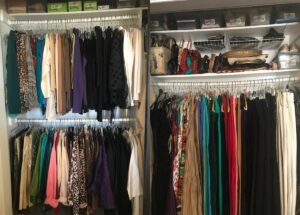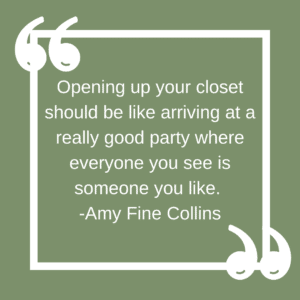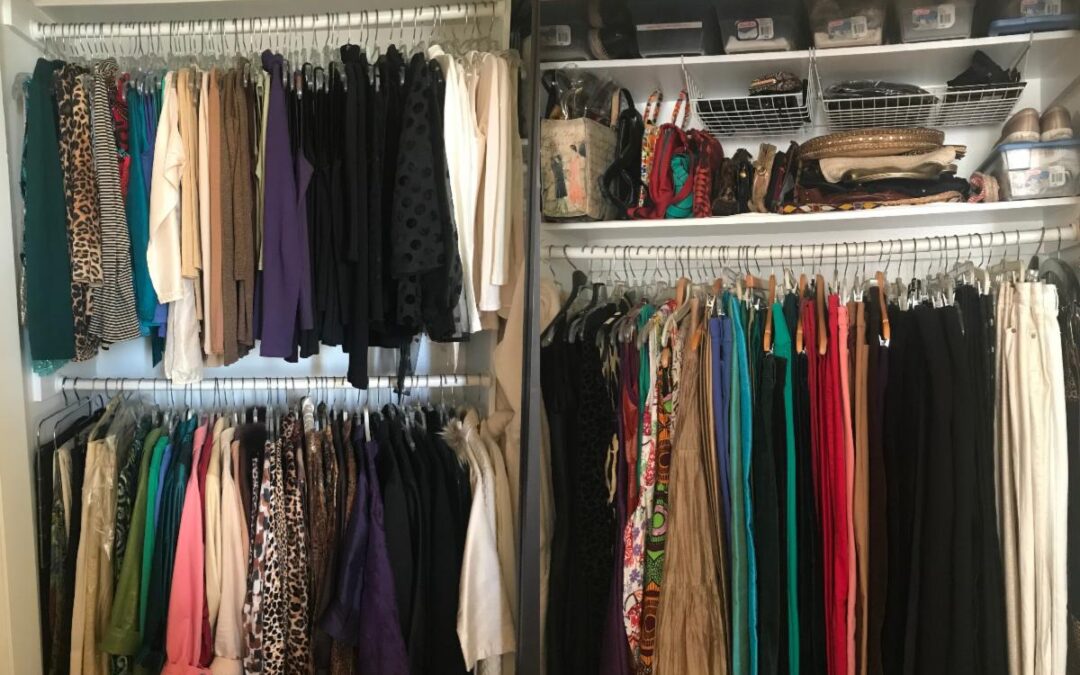You’ve evaluated. You’ve organized. Now, it’s time to purge. I’m not going to lie, this is the hardest part. The sweater you treasure from your mother that’s not even close to your best color, your style or personality. The too-long, too-big scarf that your sweet neighbor gave you ten years ago that dwarfs you when you wear it (but she’s still a neighbor so you don’t dare toss it). The pear-shaped pearl pin that your collage sweetheart gave you for your birthday (wonder if he still has the Jackson Browne album you gave him)? I know you relate and have something in your closet given to you that, if honest, you won’t ever wear. If it’s sentimental that counts. Then create a sentimental corner in your closet or bedroom. If it’s not sentimental (feelings of tenderness or nostalgia) but more sentimentality (excessive tenderness or nostalgia), consider evaluating it.
PURGING YOUR WARDROBE
There is no quick and easy way to do this, but if you do it right initially, in the long run it will save you space and time. Here’s what you will need:
- A trusted friend who can be a scribe for any note taking, assist with clothing changes, help evaluate proper fit, encourager on what stays/what goes and, if you’re lucky, that friend will wipe down and clean your closet while you’re trying on clothing.
- A full length mirror positioned straight up and down, NOT TILTED OR ANGLED. You can only get an accurate look at yourself in a mirror that is positioned correctly.
- A rolling clothing rack, if possible. Convenient for sorting clothing as you are trying on clothing. Let your friend manage this.
- Bras, underwear, shape wear, camis, tees.
- Be ready to try on EVERY SINGLE ITEM OF CLOTHING. Yes, this will be a marathon. Play music, have snacks and water readily available. And take short breaks. Do a celebration dance each time you decide to donate or giveaway an article of clothing!
- It’s easier if you try all the bottoms first (slacks, jeans, skirts, shorts, exercise pants with corresponding tops), then dresses, jackets and coats.
- Place six LABELED plastic bags in the room — DONATION, GIVEAWAY, REPAIRS, SELL, RECYCLE FOR RAGS, TOSS. Your friend will be in charge of getting clothing into the proper bag.
- Note re Toss. We are trying to keep clothing in circulation for as long as possible. Rip up old clothing and use around the house for dusting and various forms of cleaning. If you must toss items, they should be seriously stained, have rips that are beyond repair, or are in such bad condition that even a donation center wouldn’t take them.
- If you MUST, you can have a 7th bag — JUST IN CASE. But this bag will be tied up at the end of the closet purge and put in your garage, a hallway closet, a storage unit, the trunk of your car — that you don’t open for 6 months. If you haven’t gone looking for it in 6 months, donate it, or give it all away immediately. Don’t look in the bag. I’ve done this twice and have never looked back. In fact, I can’t even remember what was in the bag!
- This is an excellent time to clean your closet. While you’re trying on clothing, have your friend run the vacuum, broom or swiffer over your closet floor. Grab the Simple Green and paper towels — clean shelves, rods, crevices, corners and any stained walls. If you have a light floral or citrus essential oil, dab a few drops on a folded paper towel and place in the corner of your closet. You’re going to love putting your clothing into a clean, sparkly and fragrant closet!
- After deciding which pieces will return to your closet, BEFORE putting them in the closet, think about HOW they should be arranged. What makes most sense to you and would help you see and find your clothing easily? Do you want each category of clothing together? And do you want them organized by color as a subset within that category? Or perhaps all items together, but separated by color? If you have a color palette, would using that same color order be helpful? Have your friend return the items to the closet in the order you have decided. You keep trying on clothes!
- Accessories can be done during your purging stage (scarves, belts, etc.), but jewelry, especially if you have a lot of it, demands it’s own day and attention. It’s also a good time to clean your jewelry, it’s storage container, polish your metals and generally organize your jewelry. I organize my jewelry by color.
- Once your bed is clear, exhale, you are almost done!
- Gather the donation, giveaway and toss bags and put them in your car or your friend’s car and get them out of the house NOW.
- Store your rags bag or if a small amount place in a container bin.
- Calendar a date for organizing your jewelry and ask your friend again for help.
- Put all your supplies back, pat yourself on the back, and take your friend to dinner. If it’s after midnight, take her to breakfast! Celebrate a job well done.
TIPS AND QUESTIONS FOR PURGING YOUR CLOSET
- Take a BEFORE photo of your closet. Post it where you can see it regularly.
- Engage radical honesty. You’re not doing all this work to lie to yourself and put all those clothes back in the closet. Ask your friend to remind you of this when you want to save something for emotional reasons or “just in case.”
- How did each piece come to have a place in your closet?
- A gift (that you really don’t like, but feel guilty getting rid of)?
- A garment from family (not your color, size or style, but pulls on your sentimentality)? If you are sentimental, can you create a small space in your closet or bedroom for these treasures?
- A bad day shopping and you spent so much money on it, therefore you should keep it (to remind you how much you paid)? Consign it. Or give it to someone who will enjoy it (maybe the friend who is helping you). You will feel good about that, I promise).
- Take a photo of all the clothing on your bed BEFORE you purge. Post it where you can see it regularly.
- With each item you review, ask yourself, would I buy this item today?
- Ask yourself, have I worn this item in the last 6 months or will I wear it in the next 6 months (don’t use COVID as an excuse any longer)?
- If you aren’t already, consider wearing only your best personal colors from a professionally done color palette.
- Narrow down your best fitting pant, dress, blouse and skirt style, and evaluate others.
- Take a photo of your clean, purged, organized closet. Keep a copy in your wallet or phone. Pull it out when tempted to buy something that isn’t on your Wardrobe List, your best colors, or the ideal silhouette for your body shape.
- Place a small box or bag in your closet or close to your closet. When you come across an item that isn’t working, simply drop in the box or bag. When it’s full, close it up and take to Goodwill or your favorite secondhand store for consignment.
- Let go of the stuff, keep the memories.
MORE ABOUT JUST IN CASE
There they are — those pieces that won’t let you go. They hang endlessly in your closet for years or lie folded on a shelf. They are your “just in case” clothing. Has “just in case” arrived? Has “just in case” risen to the occasion you had hoped it would? Is “just in case” doing anything for you other than taking up space in your already-too-small closet?
I had a few just in case pieces which I allowed myself to live with for 2 years. One day I realized that “just in case” was keeping me in the wardrobe past, rather than my useful, everyday wardrobe now. I summoned the courage to say thank you and goodbye. Off to a consignment store they went. Just in case and I have parted ways for good.
SPECIALITY PIECES
The black cashmere coat I purchased in NYC 35 years ago still hangs in my closet. Do I wear it everyday? Of course not. Sometimes a few years will pass before I wear it, but it’s not going anywhere. It still fits, it’s my color, my style, my personality and I love it. It’s a speciality piece within my wardrobe. Your Little Black Dress, Merino Wool Sweater, Leather Jacket, Fine Leather Boots are all examples of special pieces. And you can save speciality pieces by storing them correctly and cleaning them regularly, if needed. The lining and the hem of my cashmere coat needed mending, so in having that done, it remains ready to wear for many more years.
And yes, you guessed it, speciality pieces need reviewing occasionally too. If they no longer fit, the condition of the garment has deteriorated (color faded, fabric worn, stretched out) or if it no longer works for your lifestyle or personality, it’s time for an honest evaluation. What about renting speciality items in the future? Saves money and closet space. Here are some options: Armoire (best curated), Le Tote(best for athleisure), Vince Unfold (best luxury), Gwynnie Bee (best for Plus Size), Nuuly Rent (best budget), and Rent the Runway (best overall).
FINANCIAL INVESTMENT AND PURGING
When we spend a large sum of money on one item and we haven’t worn it, it feels like treason to our wardrobe to give it away or send to a consignment store. And then there’s the $500 dress that we wore once. If you’re not going to wear it, let it go. Several years ago I bought a number of expensive pieces from a local designer that just didn’t get worn. Heart broken, I consigned them. And I realized that I bought them under pressure when shopping with a friend. Lesson learned!
There are times when an expensive item is warranted, like the cashmere coat mentioned above. It cost me $250 35 years ago. That was a lot of money for me then. But the cost per wear on that coat is probably $5 or less. Great investment! Next time you’re tempted to lay down $$$$ for a special occasion, consider renting it instead. And if you do decide to buy it, examine that garment extremely carefully and know that it works on every level for you and will be a masterpiece in your wardrobe.
ANATOMY OF MY CLOSET
It took four years, two masterclasses, a color course, a style course, four different color palettes, virtual style coaching, six months and endless days taking photos (the mirror doesn’t lie) to develop my closet and wardrobe strategy — the tool that helped me decide what went in the closet and what didn’t. I couldn’t get around it — the triumvirates — evaluating/organizing, purging, and curating. This was the only way I could achieve my goal of having all my clothing in one attractive closet that inspired me daily. A clean closet that was a pleasure to behold and organized according to my natural retrieval process. Each garment sparking joy. A closet whose contents were cared for and proudly displayed. Nothing hidden, no stuffed corners, just clothing waiting for me to pluck from the rod and enjoy wearing.

When I purchased this condo, the bedroom closet was just one big open space, set into the wall. I had to figure out how best to divide it based on my wardrobe needs. I love jackets, so I needed room for those, as well as my blouses. Because I hang my pants/jeans, I wanted a larger vertical space. I divided the closet in half installing two rods on the left side, the top rod for blouses, with skirts and jackets on the lower rod. The right side houses dresses and slacks. Shelves were installed above the top rods creating space for shoes and purses. I placed hooks on the wall of the right side for my belts. In answer to whether I expanded my closet to fit my wardrobe or reduced my wardrobe to accommodate my closet space that I raised in Part 1 of this series — I did a bit of both, but mostly I purged my wardrobe.
My guide throughout the process was sticking to my color palette, my current lifestyle and clothing style. Everything else got reviewed with a critical eye. I organized the closet according to item category, with color as a subset. That created a visual repetition that I find pleasing.
As I move toward a “less is more” credo and simplifying my life as I age, I envision having fewer garments with a focus on core pieces, my Vital Spring colors, favorite fabrics, my seasonal line of design, along with creative, secondhand and rented clothing.
What colors and styles are your focus now and how would that change (or not) with a conscious closet?
Closets require serious evaluation because they have a built-in personality and when we alter our closet, we change that personality. My closet personality went from “confusion” to “clarity” with an intentionally cultivated, colorful home for my favorite garments. You can do the same!

- In January of each year, turn hangers backwards on all your clothes. When you wear the item, turn the hanger forward. After six months, evaluate what you haven’t worn. Purge accordingly.
- Only clean, ready-to-wear items are put into your closet. If it needs ironing, nope, it can’t go in.
- Avoid emotional, habitual and trend shopping.
- Stop shopping! I’m currently 4 months in on a 6 month shopping moratorium.
- When a new item comes in, one piece is removed from your closet.
- Don’t overstuff cubes or bins. Perhaps time to re-organize or purge.
- Hang and fold clothes with each use.
- After 6 months evaluate the organization of your closet. Is it working for you? Does anything need adjusting or re-thinking?

